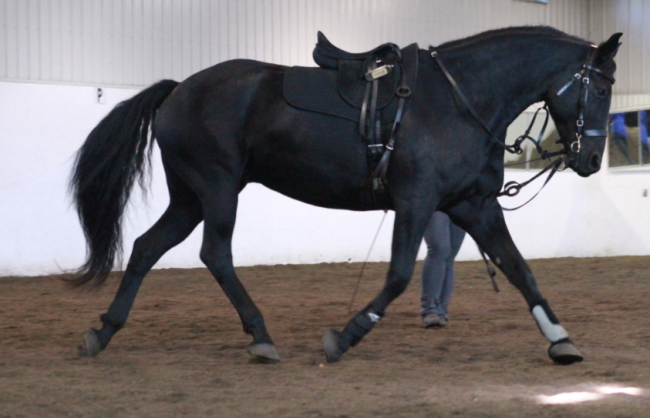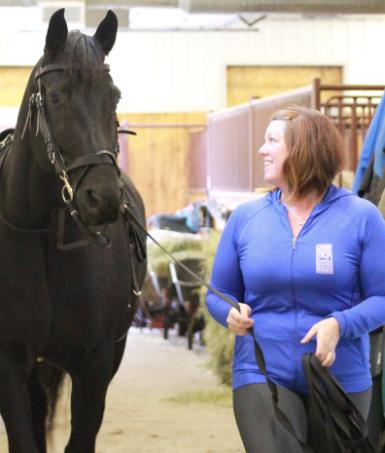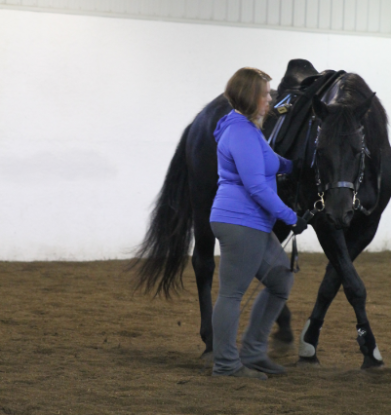The Dreaded D Word
Dressage as I see it – An invitation for the casual rider.
By Staci Grattan – Spirit Horse Center
As a born and raised “backyard rider” I’ve had horses basically my whole life. I come from a line of “do it yourselfer” backyard horsemen and women.
As a preteen from a financially challenged family I joined 4-H and decided to give showing a go. We lived about seven miles from the local fairgrounds so every year I would ride my horses there (we didn’t have a horse trailer) and spend the week showing in 4-H classes pertaining to western riding and occasionally an open halter class. While at those show grounds I saw kids who had trainers and coaches and horse trailers and fancy saddles (and more than one saddle?) and rode “English”. I remember watching the parents “warm up” the horse and wondering why they were running their horses around in a circle on a long rope? What! Keeping in mind this was nearly 30 years ago and I was a self taught backyard rider you can understand my amazement and confusion.
This was my first exposure to “English” style riding and it formed a lasting impression.
An impression I believe many of you will be able to relate to.
I recall scoffing at the people running their horses around like crazy in circles on a long rope before the kids would climb aboard. I remember thinking “why are these people running their horses around and tiring them out before they get on?”
I remember looking at the tiny “ridiculous” saddles and thinking “yeah not in this lifetime” at the direct contact reining and thinking – “Sheesh why are the pulling on that poor horses mouth like that? That’s just terrible!” And asking the question – “don’t they do anything other than circles?!”
Words like canter, collection and contact had no place on my vocabulary at that young age and well into my 20s. Dressage and “English style” riding seemed silly, pointless and frivolous.
In my late 20s I had a pretty hot trail horse. I was in over my head but unwilling to admit it. I decided I needed “a better seat” and began exploring local riding instructors and researching training and riding concepts. I ended up with a local dressage instructor and began my love affair with dressage.
A lot has happened in my horse life since then, from private backyard breeder to commercial stable owner where I do some training and riding instruction, from training with a local instructor to training regularly with internationally recognized Natural Horsemanship and Classical Dressage experts, however my love of dressage and its most basic and simple offerings remains. Dressage is not rocket science – it’s just good solid basic horsemanship!
This article speaks to all horse lovers. However as a former casual, self taught backyard rider who was intimidated by “that fancy dressage stuff”, I invite casual riders and horse enthusiasts to explore the value of the principles, teachings and philosophy found in the oldest form of horsemanship.
Why Dressage?
1) Health, wellness and longevity.
I believe good horses are like fine wine – they just keep getting better and better. Lets face it , we put a lot of love, time and energy into our horses and we want them to last forever. Proper body mechanics by horses under saddle go a very long way toward joint longevity and injury avoidance. We know this to be true of any athlete, and horses are no different. The concept of collection as well as self carriage are valuable concepts for any horseman or woman to explore and implement. Physical collection in the horse not only makes for a more pleasant ride it also potentially saves your horse from a whole host of injuries and promotes long lasting physical strength. True physical collection and proper body mechanics are an integral teaching in Classical Dressage. Note I did not say Competitive Dressage as in my opinion that is another topic entirely.
2) Decrease negative tension.
Dressage teaches us to “ride every stride” and think ahead.
Dressage horses look “hot” and out of control to many casual observers – and they can be. However the goal and teachings of the Classical Dressage Masters I have studied and studied with is to increase sensitivity certainly but decrease tension. The more aware we are, the more “with” our horses we are. Many Classical Dressage Masters promoted a partnership and dance with the horse. Side note – horses who are moving “correctly” with heads down and back lifted are taking direction from their riders and remain much calmer– horses who are moving along in “anti collection” (term coined by Dr Deb Bennett) back hollow, head up in the air, are often not really “with” the rider, carry tension and possibly have more of a propensity to spook etc.
3) Connection, physical and mental assessment and riding preparation.
Many Classical Dressage teachings include groundwork in the form of proper mindful lunging and in hand work. Please note I say “mindful” lunging in which the horse and human are mentally connected and the human is paying attention to the horse! When I say “properly moving” I mean that the horse is coiling his loins, stepping under himself, lifting the base of his neck higher than the haunches and lifting his back as best he can based on his physical fitness level and conformation.
Not only are these things very valuable tools for connection on a deeper level, they also allow the human to do a physical and mental check in with the horse. There is huge mental and physical value to lunging done in which the horse must move correctly at a walk and a trot. Side note – do NOT underestimate the mental and physical benefit of working with your horse at a walk on the lunge line.
In hand work, as taught by several Classical Dressage Masters, also offers benefit to nearly any horseman as a tool for several reasons:
a) Lateral work done in hand such as shoulder in, keeping in mind physical limitations and conformation, offer an opportunity to address physical or mental limitations from the ground by strengthening and suppling. Difficult canter/lope departs can be improved with shoulder in work either under saddle or in hand.
b) In hand work (as well as lunge line work) offers a great opportunity to work through mental and physical issues. The saying goes “if it’s a problem on the ground it will be a problem up top!” Why not address tension, anger, insecurity issues from the ground where you are able to offer more support?
4) Contact = Conversation = Partnership.
Classical Dressage teaches us about contact with the rein. Contact is a two way conversation between the horse and rider – we do not have an unmoving “death grip” on the rein nor do we ignore it entirely until we need to stop or turn. Rather we are constantly and lightly in touch with each rein and varying the pressure by a light give and take. Contact can be accomplished with a loose rein if that is your style. The point here is that contact is a method of conversing with your horse – much like your seat and leg, we are creating a conversation and ultimately a partnership.
Any time you can broaden your horsemanship horizons it’s bound to be a positive experience. There are many “roads to Rome” and in this case many of the principles I outline above may or may not be covered in other disciplines. The true purpose as I see it of Classical Dressage is care for and partnership with the horse. Training is done on a slow and consistent basis always keeping within the comfort zone of both partners without shortcuts, or gimmicks. As truly the oldest form of organized horsemanship, dressage offers proven and time tested methods for your consideration. Check it out! You might just be amazed at how basic and simple the concepts are and how universally they apply to all levels of horsemanship and span disciplines.
Staci Grattan and her husband Brion Fornshell co-own Spirit Horse Center in Brainerd, Minnesota. Staci enjoys using her focus on good solid horsemanship basics, true classical dressage and natural holistic horsemanship to assist horses and humans. Spirit Horse Center is located in North Central Minnesota and provides, boarding, training, lessons and regularly hosts clinics and events benefitting horse owners and horses.
For more information on go to http://www.spirithorsecenterinc.com
Photos feature – Legend 8 year old Friesian X Quarter Horse gelding.
Photo 1) A shared connection and proper body mechanics on the lunge line can be beneficial in multiple ways.
Photo 2) Connection and partnership – the ultimate goal in any form of horsemanship including classical dressage
Photo 3) Lateral in hand work can be beneficial in multiple ways including addressing strength and flexibility issues, mental relaxation and focus and mutual connection.


